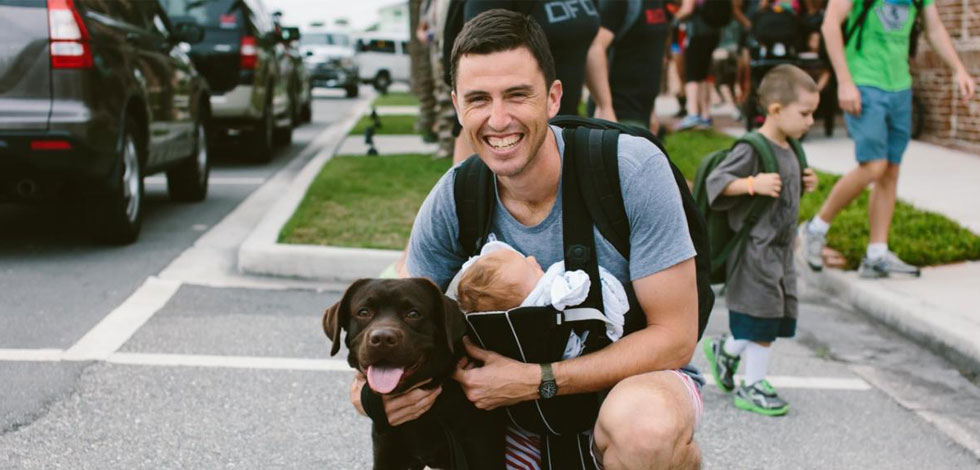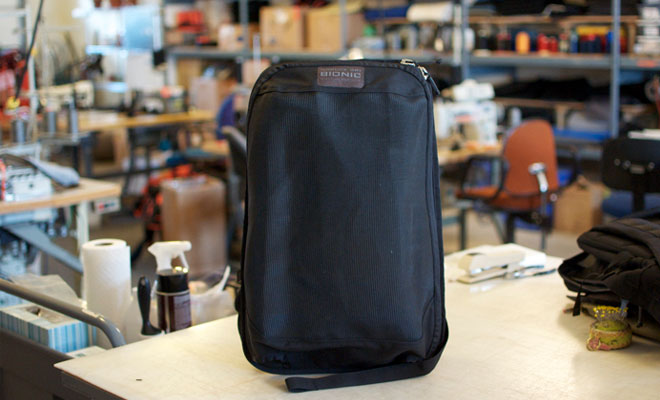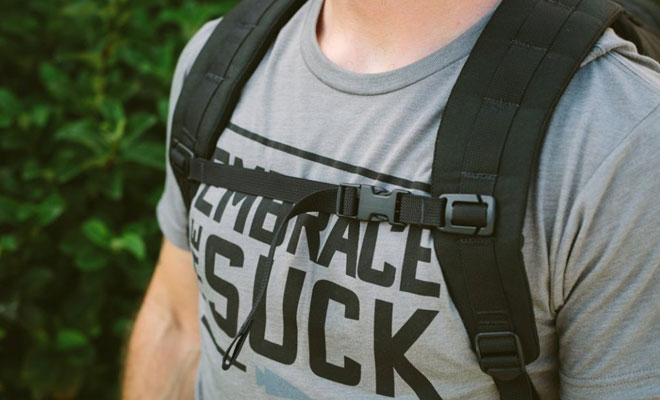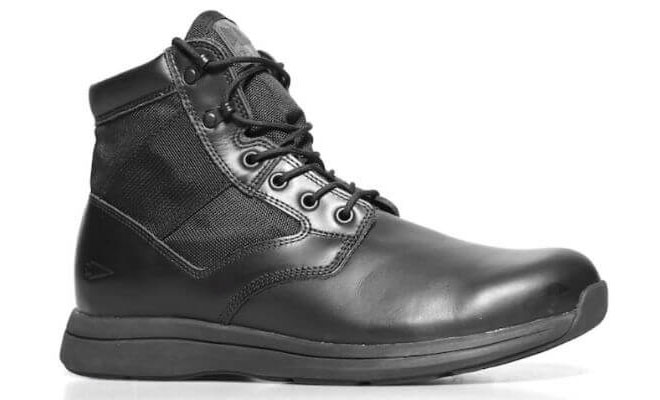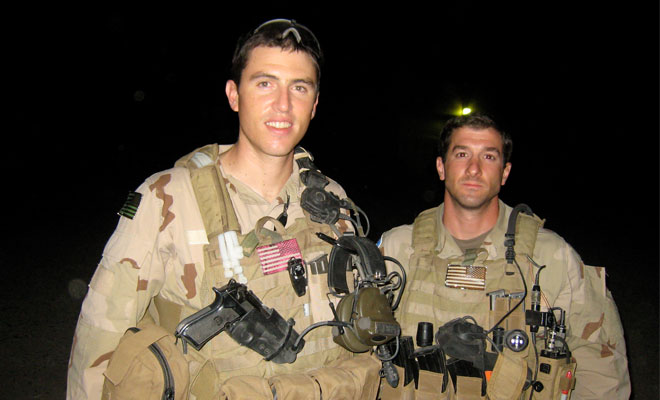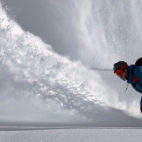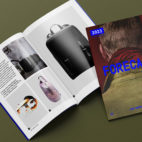A Conversation with GORUCK Founder Jason McCarthy
When it comes to cult carry brands, GORUCK is right up there at the top of the list. And for good reason. They make some of the toughest carry gear around (with plenty of GORUCK Challenges attesting to its durability). But they’ve also built up a passionate community who are fans not just of the gear but of the values and ethos that GORUCK has maintained from the get-go. Recently Carryology Classified was honored to host a Live Q&A with GORUCK founder and CEO Jason McCarthy. Find out more about the brand and the man (and community) behind it in our conversation below…
What brings you the biggest joy in your business and what are the daily or weekly things that you most enjoy?
For me GORUCK is a lot more than ‘just a business’. And so the best, most rewarding part is the community and the people that I get to work with. That come to our events. That have made GORUCK about a lot more.
A brief history on why I started this, it was never about building the GR1. It was never about the gear. Yes, there were some skills that I’d learned with regards to gear in the Special Forces, but it was a hobby at the outset. And it took years and years to get to the point where the GR1 was about where it still is now, almost a decade later.
All of that said, if it weren’t for the community of people that I met through the GORUCK Challenges and, furthermore, the people that I get to work with here at GORUCK headquarters and GORUCK Scars, then I would not be doing this still. My goal has been to sort of honor my roots in the Special Forces and serve America. And live by these values and ideals that are really important to me and to our way of life. So that’s what keeps me going in all of this.
And the best part about that is when you get to celebrate some kind of success with other people. Some great feeling of finishing a Challenge with a class, with a team. That kind of stuff. That’s really motivating to me. And then there’s a lot of internal stuff as well. You design something for a really long time, it comes out, and people like it. I mean, you guys…we work for you, not the other way around. So the people are the best part.
What is the hardest or the most uncomfortable thing about being a boss at GORUCK?
Well, people are the most rewarding and also the most challenging. So I want everybody to succeed. I want classes to succeed. I want my kids to grow up and be happy and confident and successful in however they get to define it. So the hardest times here are when somebody leaves that you love and they say goodbye or vice versa. Because this is a family and a community inside of our headquarters as well. So we feel it when people come and people go. It’s great. It’s just kind of the nature of it and sometimes that’s been pretty hard.
If you had another hour to each day, what would you do?
It depends on the day, right? But spend another hour with my kids. Some days I want to work until midnight. I want to work until I don’t wake up in the morning and start it all over again. Some days you’re just shot and you just go home earlier and take the kids to the beach, or something like that. What I don’t want is that there’s not this big divide for me between being at work and being at home and being on the road and all those sort of things.
And the real value in all of this is finding the right balance. Spending time with the people that you love and still an honest day’s pay for an honest day’s work. And figuring out what that looks like in your own life. And only you can answer that. So I’m trying to figure it all out like all of us are. If I could add another hour into my day, I would. If I could add 48 hours more into every day, I would. I go to bed wishing I had more time and I wake up and I say, “Thank God I got another day. It’s awesome.” I’m just at a really good place with the sort of work/life balance. All of that good stuff.
“What I did not foresee was the impact it would have on people. So that became very much a part of where GORUCK stole my heart, those first classes and then subsequent classes after that where I just saw the impact that GORUCK was having on people”
What is your daily carry?
My routine is I wake up in the morning and I take my youngest son, Ryan (he’s about a year and a half) and I put him in a front-loader that we did not build, but that we sort of customized a little bit on the front. It says, ‘Embrace the suck’ instead of the lame-o brand tag that it would otherwise say. And I put my Rucker on with usually a 30-pound ruck plate. Sometimes it’s a 45, but that gets to be a bit much as he’s gotten a little bigger and is now about 30 pounds. So I use that in the morning.
Then I usually bike to work and it’s about four miles. So I’d love to say I ruck everywhere all the time. Not true. I live a little too far away for that. To do every day anyway. But when it’s product testing time, I do that a lot more. And then when I travel it’s my GR1. I have my laptop and I have a windbreaker. So that normal stuff. Nothing crazy. I don’t have some big broken-down AR15 or some 50 Cal everywhere I go, or anything crazy like that.
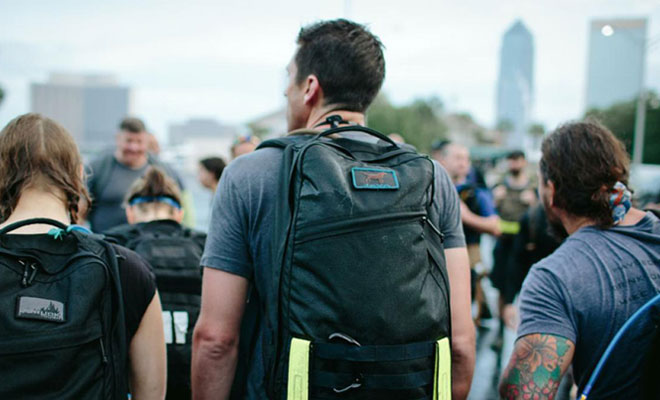
What’s one thing about GORUCK that even its most die-hard fans would be surprised to learn?
I still have to think about that. I’m not entirely sure what that is. I mean there might be some answer like: how much it hurts to disappoint them. But hopefully they know that we’re really disappointed if we let people down. In any way. Something fails, or the event wasn’t a home run. Or we weren’t perfectly clear on whatever communication we sent to y’all. And stuff like that. We’re really humans too and so…just that element. We are actually humans, we’re not sidewalks. Maybe that’s it.
GORUCK is one of the most cult carry brands, why is that so? What’s the secret sauce?
Well, the secret sauce is that there’s not really a secret to it. The lessons that have worked, the fundamentals, which it always comes back to the fundamentals, are the same that I learned in Special Forces. Which is how to build a community. So here’s an example. The classic Special Forces mission, that everyone kind of recognizes, post-9/11 a couple of hundred Green Berets moved into Afghanistan, linked up with the Northern Alliance and then worked with the Northern Alliance to defeat the Taliban, with the United States Air Force. What they did not do was just go force on force and have Green Berets vs the Taliban.
So the point of that is saying unilateral action, like a business just doing its own thing and not engaging, and not force-multiplying, and not building communities, is a really expensive way to do things. In war it’s bloodshed and are you really winning hearts and minds? In business we have limited resources as well. So how are you going to deploy those? If you can create raving fans, then they’ll do the work for you. So it really is just modelled directly after my time in Special Forces and that’s what I knew
Can you give us some insights into the GORUCK Challenge?
It’s a major part of what we do. The inception for those was, as you all know, GORUCK stuff costs a lot of money. It’s really expensive. When I was in Special Forces, we always had the best gear and you would pay more for the best gear. That said, a lot of it was issued… You had separate credit cards, you had allowances or allotments that you were given. So you weren’t really paying for your own stuff, at least most of the time.
And $300, about to be $400, for our signature rucksack, GR1, is just a ton of cash. In the early days, I thought that $295 was just a death sentence for us. It was too expensive. We’re an unknown brand. And then I thought… Well, I made my peace with the fact that it’s really an awesome rucksack and then people will buy it. And the truth is that they don’t just come to you. Nobody’s going to do the work for you. The industry is not built around welcoming newcomers into their field. That’s just not how things work.
So the challenge was I don’t know anything about AdWords. I don’t know anything about Facebook ads. I don’t know anything about digital marketing. And this was 2010. But I do know how to build teams. And I know how to engage people and build communities and get them engaged in a mission that we’re doing. So that’s what the Challenge was. It was designed to kind of ‘market’ GORUCK.
What I did not foresee was the impact it would have on people. So that became very much a part of where GORUCK stole my heart, those first classes and then subsequent classes after that where I just saw the impact that GORUCK was having on people. And that was a really powerful thing. So it made it a lot of fun for me to keep going with GORUCK. I’d say, without the Challenge, nobody’s ever heard of us. Because just, I say ‘just’ a gear company. Not like that’s easy because that’s really, really hard.
But the business mechanisms of marketing a gear company are difficult. And it’s kind of in isolation and I kind of prefer communities and teams and stuff like that. So the events and gear have very much always been one GORUCK in my heart and I wouldn’t have it any other way.
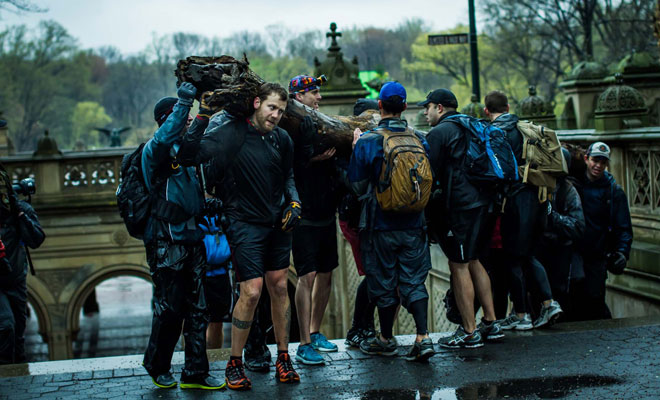
Could you share one nugget of wisdom learned from the Special Forces?
The Special Operations Troops, the SOT, Special Operations Forces Troops, the first one is: humans are more important than hardware. And that’s always true. So it always comes down to people. I’ll give you an example. The GR1 is cool. If we build you a perfect GR1 right here, that’s great, right? But the people that have to consistently ensure that it has quality at the manufacturing level, at the quality control level – and you are also in quality control for us. Little secret. Through the GORUCK Challenge. Testing it at 1,000 events a year, stuff like that. It makes sure that we’re doing our very best all the time and that we have the stops in place to find out if anything goes off-kilter.
So the humans are more important than hardware. And to build a team you have to find great people that are aligned with your culture and your mission and you have to empower them and you have to hold a standard. And we have to hold each other to certain standards. Special Forces is at the tip of the spear, but it’s nothing unrecognizable at a human or a foundational level that anyone could recognize. There’s just a small team, a small community, of people that want to do excellent stuff and service to something higher than themselves. The mission, you know, take your pick. God, family, country. And then it’s just like a pack of wolves making sure that they stay as sharp as they possibly can.
And that’s the ethos and the way of life that is internal to GORUCK. It’s a common theme. I mean, yeah, we say a lot of Special Forces this, Special Forces that. Internally here, though, almost everything that we have (I can’t think of anything that’s not) is built upon that background of Special Forces. In the how. How it does. How you do things. Not just the one raid and whatever, with the beards and stuff. But the process of team building and how you hold each other to account and stuff like that, which is great.
Can you comment on the recent price increase in GORUCK gear and why?
So the price increase. We’ve been talking about this and looking at this for a while. GORUCK has been fortunate. Because of our business model, we have events and we have manufacturing, right? So now we have not only rucks and gear, but we have apparel and we have footwear and stuff like that. And we also have events.
Now, the capital outlays for each of those, the cash outlays, if you will, is very different. So events is cash today for a future service. And gear is the opposite. You put money down sooner for gear that’s eventually there. And then you have inventory holding costs. The time value of money and stuff. So it’s expensive to carry inventory.
In ten years, because GORUCK started in 2008, the business has been entirely fueled by kind of taking GORUCK events’ cash to buy inventory and running the events at a future date. And doing all of these kinds of things. Yes, my step-dad invested $150,000 at a more than fair evaluation back in the day. He got 20%. And that’s been the only outside investment to date into GORUCK.
So we have the control to be free to do things the way that we want to at GORUCK. And what I mean by that is, we’re able to do things that we think are right. It’s a lot of times different than what someone in private equity would say, “Oh, you’re not doing this. You’re not doing that. Your growth curve is this and you’re not getting enough return on your money” and all of that kind of stuff. We’ve avoided that entirely in the efforts of building a true brand.
And so where we are now, and where we have kind of always been, is it takes retained earnings, so profits, in order to grow the company. And we’re just not at a stage where we’re able to turn profits for growth. And so you start looking into it and say, “Hey, are we operationally efficient enough?” And we did that for about a year and a half, and looked at everything and it’s like, “Yeah, we’re pretty operationally efficient.” You start looking at what payroll is. You start looking at what labor costs are from the vendors who manufacture our gear and stuff. I mean, prices have gone up, inflation’s happened, all that stuff. So it’s a lot of various factors, but ultimately, if GORUCK were raking in money and we were able to grow at these prices, we would not be raising the prices. So we’re having to eat a lot so far on profit margins and stuff like that.
So, in order to make sure that we can continue to grow and do a lot of R&D and do a lot of events R&D and do a lot of the things that make GORUCK GORUCK, it’s just a necessary reality. I’m not especially happy about it. I would love for things to cost less. I would love to be more accessible. And the part that I’m very aware of is that GORUCK is more populist than elitist by any stretch of the imagination. And so it’s more how do we stay elite without being elitist? And that’s a fine line that we’re going to have to walk and navigate through because the higher the prices go, the harder it is to remain elite without being elitist.
And yet, the price of the events is still really low, relative to anyone else out there. And we would rather see you than ship to you. So there’s that, right? So there is the community side that’s a lot more accessible. And that’s intentional. That’s where my heart lies. I would rather that we’re able to sort of put more people through our events and actually meet more of you in the real world. I think that’s a really missing thing these days. Where Facebook communities, and all that stuff, are, at times, replacing the need for real human interactions. So our goal is to see more of you and continue to do the things that make GORUCK GORUCK. Like I said, not super happy about it, but it kind of is what it is.
“The GR1 was meant to be a piece of art that just happened to be able to get dragged behind a Humvee from Bosnia to Baghdad and still be fine”
Can you talk about the potential for customizations?
We’ve had a lot of variations of GR1 over the years and, ultimately, as in any business, I mean, we like to love everything that we put out, right? I’m not going to say every T-shirt design we’ve ever put out has been awesome. But the big stuff, GR1, GR2, GR3, Echo, Rucker, all these kinds of things, they’re great. And people wanting customizations and modifications to those is… We’re happy to do it as long as it makes sense for us, for our team here. Because we can’t just go down the rabbit hole of building one-off custom stuff for everyone, unless it is just at an exorbitant price, which gets back to the point of ‘we’d rather be more populist than elitist’. And that’s just a fine line that we’re going to have to walk.
We see a lot of requests come through and we’ve just had to build out a team here that can manage those requests. And it’s an operational process. We would love to do things faster. To service more people better. You know, do you want a bottom handle on the ruck? Great, we can do that. We’ll show you how we can do that. Do you want your side handles? Do you want grommets? Do you want drain holes? Do you want all these things? Sure, great. We can do all of that. And we can and we will. We’re just at the point now where we’re close to being able to offer that option. And Scars, having that here, also keeps us in touch with you all.
So I get that there’s a lot of people who want more customization and they want more alterations. More versions. More styles. As GORUCK gets bigger, there’s natural pressures and tendencies on that to happen. And we’re happy to do that.
What’s your thoughts on the GORUCK aesthetic and the use of MOLLE webbing?
There are a lot of gear enthusiasts with a high sense of aesthetic values. The issue of MOLLE webbing coming into play, I mean, MOLLE is a military-used form of how you make your gear modular, right? And so, from the very beginning, from the very outset with GR1, we were reluctant to put it all over the place, which is a really common thing in the tactical carry world. We wanted it to be more beautiful.
The GR1 was meant to be a piece of art that just happened to be able to get dragged behind a Humvee from Bosnia to Baghdad and still be fine. It’s meant to endure all of these kind of Special Forces deployments, and all of that kind of stuff and still function perfectly. And by a piece of art, I mean simplicity is the ultimate sophistication. That’s a Da Vinci quote, I think. And so when you remove everything that you can possibly remove, then you’ve just got the bare minimum and then there’s less things that can break, less things that can go wrong. And it just works better.
So that’s been the goal. That’s our aesthetic. I’m not religiously opposed to MOLLE stuff. We’re actually working on a new pack. It’s 500D that’s got no MOLLE. It’s got some reflective strip on it. It’s built for rucking because that’s kind of what we do here. But we’re happy to explore new and other stuff over time. Without wanting to pigeon-hole ourselves, we’re known as the sort of military Special-Forces-inspired packs that are really tough as hell. And so you can never deviate too far from that.
And yet we had to carry that ethos to apparel and to footwear and try to do that seamlessly. You can never do it seamlessly, but try to do it in a way that one leverages the other and, over time, you know, 10 years, 20 years later, you look at what we kind of have in our GORUCK universe. Notice there’s no MOLLE on our boots or on our pants or anything like that. So we’re happy to do more pieces that have less MOLLE. We just have to come up with a way to sustain the story on those. Meaning a certain line, a certain this, a certain that. And we’ve got to be big enough to where there’s enough of you that are looking for something like that.
We like running that stuff through workshops, which is our version of Kickstarter, I guess. And which served a couple of purposes. Mostly on the business front. It’s cash today for a future liability of a piece of gear. But, even more importantly than that, it allows us to perfectly forecast the known demand at that moment in time so that we can service it better. And that’s fun for us. It’s cool that you guys can get what you want or ‘buy it early at a discount, get it later when it’s done’ and we don’t burn that much cash buying something that you guys don’t want. Because, like I said before, we work for you and not the other way around.
When will we hear more about that 500D pack?
Well, I can share a little more about it now. It looks kind of like lots of our stuff. Just an integrated hip belt. One main compartment. The first prototype is not quite where it needs to be. So it gets sort of kicked back to make some minor modifications. What I’ve found over time is that you spend about 90% of your time on the last 10%, if you want it to do something that’s really, really awesome. And it’s really, really easy to quit at the 90% solution. Meaning you say, “Oh, it’s good enough. Let’s kick it out the door. Let’s not test it. It’s good. It’ll probably work pretty well. People will probably want this.” That’s a really easy thing to do. It’s also a pretty horrific trap to fall into.
Where is the most common wear on your bag?
I don’t know. We see a broad array of everything. It depends on the usage. We’ll see some of the shoulder straps fray at the seams. The shoulder straps are surprisingly really hard to build. With a fray at the end of the shoulder straps it just means that a sewer missed a seam allowance by this much. Everybody thinks that there’s some machine out there that’s doing graphic design on the gear. It’s not the case. These are really hard to build so we had to replace them after however long. And this is just a component piece.
I also wanted to touch on the dual-density foam. That has been one of those differentiators for us in terms of which exact foam from which exact place, laminated with which exact laminate, laminated to which exact other foam? Because it’s kind of like the workhorse inserts in our boots, right? Usually you get those insoles in any pair of cheap running shoes or almost any shoe out there. It’s that really thin piece of foam and it’s meant to feel kind of ‘cushy’ when you’re at the store or when you try it on. But what happens is that it just disintegrates. All it’s really doing is preventing the abrasion that would happen if you removed it from the actual bottom of the foot. And it just collapses down and it might as well be a Kleenex tissue in there, right?
Well, the same thing with backpacks and rucksacks. If they don’t have this kind of secret sauce of foam or something comparable… If it’s not over-built to carry weight… And, by the way, what’s the purpose of a rucksack or a backpack if not to carry weight over long distances and make it as comfortable as possible? That’s sort of the basic, most foundational goal of what that is.
Then you get into how much weight over how much time and distance, and then you’ve got the need for varying packs and how you distribute the load and stuff. But it’s the same with shoulder straps as it is with a premium insert into the boots. Anything can feel good empty in a store. These are just the small differences that go into making something that’s the product of a commitment to supreme quality. So there’s lots of those little things embedded in lots of our stuff and that’s pretty cool.
“At any one time there’s Green Berets in 75-plus countries, thousands of guys spread across the world. And not in the garden spots. In all the worst spots. That’s where they want to be.”
Can you comment on the issues related to creating GORUCK footwear?
So the issues were basically the same as getting into GR1. I don’t have this background of, “I’m going to manufacture something.” I’m coming at this from a completely different angle, which is as a user. As an abuser with a background in Special Forces. So you see the best. You know what, when or why or how something’s going to fail. And you just get really comfortable understanding what makes great gear. And it’s usually simple. Simple gear that just works is the absolute best. And so without Paul, the footwear would not have happened. Period, the end.
It’s really easy to get out there and ‘private label’ something. Find someone else and you kind of put your skin on it and then you’re in charge of marketing and all that stuff. But it’s less good, if you’re actually in manufacturing, to do that stuff. At least for us.
I guess the full story is: Reebok. Why it got accelerated. Reebok approached us about working with us on the events space. As a title sponsor and whatever that is. Well, they have to monetize that, of course. And so that led immediately to footwear because Reebok is ultimately a footwear company. And so that started the discussion. That’s where we met Paul. That journey lasted for a year and a half. Something like that. And for what Paul says are very good reasons, we went our separate ways and decided not to work with Reebok, but we had learned a lot in that process. So we got a really good education. There were a lot of great people that I met at Reebok.
The CEO Matt O’Toole called me the first time and just wanted to sort of chat. He said he was a big fan of GORUCKsters. The manager at the Fairmont Hotel in DC, who we worked with on the event space, is who contacted Matt because they’d been friends for a while and small-world stuff. So he reached out and we chatted and got to know them pretty well and really liked them as people. It just didn’t really work out on the business front. But I stayed in good touch with a couple of them from that time and learned a lot. And once you learn a lot, you get kind of an itch. And that was the itch and Paul was looking to do something.
So I don’t mean to downgrade the problems. I mean to say that the problems were everything. Like everything. And that’s the same thing that we went through with GR1. This was the only process in GORUCK, the MACV-1 footwear, that reminded me of that original process. So I was very comfortable with that. It’s kind of like if you’re a Green Beret and they send you to Afghanistan, you might be fighting in the mountains. If they send you to Iraq, you might be fighting in Baghdad. You might be fighting in the mountains up north. If they send you to the jungles of Vietnam, back in the day, you’re probably going to fight in the jungles. It’s a lot of different terrain.
But the fundamentals are the fundamentals and you hold the line and you hold the standard and you maintain what that is and you stay true to the value proposition that you’re providing. So the rucks that we build are really tough and they’re really good for carrying weight. Guess what? The footwear is really lightweight. It’s the opposite of the rucks like that, but they’re really good over long distances and while rucking. So while carrying weight.
I was chatting with Rich and we were like, “If you were a Special Forces guy and you were going to do any mission set like that (any of the warfare environments), these are the only boots that we would choose.” And that’s the same thing that we would say about an assault pack, GR1. Now it gets a little specific with some of the medical packs and stuff like that, but the footwear’s kind of a no-brainer on that front. For us, anyway. So you guys will get to decide once you get it out there. We’ve got thoughts and opinions and we welcome yours and your feedback.
Would you make your GR2 with no external MOLLE like your GR3?
I don’t know that we’re going to do it right away, but, yeah, we’d consider that. We haven’t had as much luck with Slick stuff or stuff without MOLLE as we have stuff with MOLLE, but we talked about doing a GR2 workshop. It’s just, the GR1 workshop didn’t kill it with that. I’ll just say that. So we sold, gee I don’t even know how many units. Maybe 1,000 units or something. But there were so many different SKUs. So, look, 1,000 units. That sounds like a ton, right?
The problem is that when there’s that many SKUs, it’s a new process and some of the SKUs were really low. Some of the SKUs were higher. It gets complicated. Why bigger brands are able to offer more styles is because they can support higher minimums at the factory level and all that stuff. And the factory vendor relationships are the thing behind the scenes that make all of this work. Without them, we can’t scale up rucksack production. We can’t grow as a business because that’s the number one driver for what we do.
What made you join Special Forces?
So I joined Special Forces because of 9/11. I was really mad. I was not super happy about what happened to us and, basically, I wanted to fight. So that’s why I joined up. And, you know, sort of signed up for revenge reasons. And, ultimately, the service component of service to God, family, country. And sometimes none of that mattered and it was only about service to the guy to your left and the guy to your right.
That’s a way of life that I took from my time in the service. And whether the military is for you or whether the military is not, or wherever life leads you, finding a cause to serve that’s bigger than yourself and literally pouring yourself into it is not something you’ll ever regret. I don’t regret it for a second. I’m really proud of my service and I’m proud to still be associated with the guys who’re out there doing it right now.
At any one time there’s Green Berets in 75-plus countries, thousands of guys spread across the world. And not in the garden spots. In all the worst spots. That’s where they want to be. And it’s a hard job. It’s a rewarding job. And it’s an important job. We’re sort of part diplomats, part ambassadors, part all of those things for the American way of life. And I believe that Special Forces guys do an extraordinary job and they do it really well.
So it’s a great community and I hope that’s one of the themes that you take away from this, is that communities really matter. That’s the best part about Special Forces. That’s the best part about GORUCK. And I was really happy to see that the Carryology team started up the community this way. Through Carryology Classified.
It’s been awesome chatting with you guys. Thanks. I appreciate your time and I’ll see you around.





 Carry Awards
Carry Awards Insights
Insights Liking
Liking Projects
Projects Interviews
Interviews
